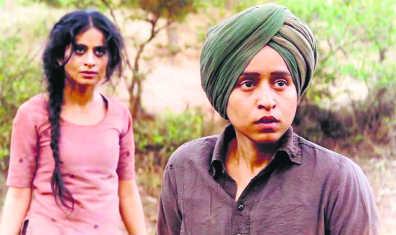
Tilotama Shome as Kanwar Singh and Rasika Dugal as Neeli in ‘Qissa.’
Vandana Shukla
Few films are made on the theme of the Partition, fewer go beyond the blood and gore of the historic blunder of 1947. ‘Qissa’(folklore), a Punjabi film, an Indo-German production released in India recently, compensates for a lot that has remained untold and unexplored on the subject.
The film opens a page from the bloody chapter of the Partition in undivided Punjab. From there it moves languidly to explore the terrain of communal violence, complexities of gender and identity in post-partition Punjab, within the realm of ever-growing power of patriarchy. It ends in a cusp where real and phantom identities intertwine. The phantoms — creation of this complex web — once released, are hard to be retained by the chapters of the past history. They spill over the present.
Unlike the Holocaust of Europe that continues to inspire Hollywood to produce films based on the theme every few years, in India, rarely films have explored the loss and suffering of uprooting inflicted by the Partition, seeing the scale of bloodshed and forced human migration it triggered. Ten million people were displaced and close to 1.5 million were killed in one of the bloodiest chapters of Indian history. Thousands of women were raped and separated from their families, on both sides of the hurriedly drawn Radcliffe Line.
Largely dominated by Punjabis, Bollywood has failed to produce films on a theme that affected the community the most. Even when the theme is touched upon, it rarely moves beyond the love stories of the estranged Hindu-Muslim communities. Few good films like ‘Garam Hava’, that explore the identity crisis caused by the Partition, have been financed by the National Film Development Corporation of India. ‘Qissa’, directed by Geneva-based Anup Singh, too is financed by NFDC. Often, foreign funding has helped making of films on the Partition. ‘Train to Pakistan’ a 1998 Hindi film adapted from Khushwant Singh’s 1956 novel by the same name was directed by Pamela Rooks. ‘Earth- 1947’, a film based on Bapsi Sidhwa’s novel ‘Ice Candy Man’, and later ‘Midnight’s Children’ based on Salman Rushdie’s novel were produced and directed by Deepa Mehta. But these films remained largely foreign to the Indian audience, unable to touch a chord. The nuances of the tragedy were lost in translation.
Religion- the sole identity
One can think of M S Sathyu’s ‘Garah Hava’, 1973, as perhaps the only film on the theme that handled the breaking up of Muslim identity with delicate insight. The film focused on a Muslim family of Agra, where the community dominated the shoe-business. The plight of Salim Mirza, played by late Balraj Sahni, whose family members leave one- by- one for the lure of the Islamic state of Pakistan, leads to slow disintegration of the family and, on a macro level, of a community whose generations were integrated with the soil of the land.
The film deals with the sneer and distrust the Muslim community had to cope with —from two sides — from those who migrated to Pakistan and those who constituted a new India. The way Mirza adapts to the complete transformation of the shoe-business ecology is heart rending. That, the appearances were that of a religious divide, the real factors were political and economic, is finely tuned in the plot. The film leaves a lingering impact which is poignant.
Though made in Pakistan, a French/German production, ‘Khamosh Pani’, 2003, was another film to bare the threads of religion-based identities and their disintegration due to the Partition. A middle- aged Muslim widow’s life in a small village of Pakistan in the 1970s, goes topsy-turvy when a visiting group of Sikhs from India start enquiring about Veero, a Sikh girl, who was left behind during the communal massacre of 1947. Veero was among several other Sikh girls who were prompted to jump into a well to save their honour. Afraid of the well she runs away, gets raped and later marries her rapist, who undergoes a change of heart.
Veero, now Ayesha, never goes to the village well to fetch water, the peculiarity of her behaviour, played by Indian actor Kiron Kher, prompts the bother of Veero, a visiting Sikh to suspect, she could be the one he was looking for. Chandra Prakash Dwivedi’s ‘Pinjar’, based on a story by Amrita Preetam too dealt with tangled religious identity of a rape- victim, Puro.
Personal is political
In ‘Garam Hava’, a freshly carved out country, a new Shangri La, shapes new identities for the Muslim migrants. This new identity, of a complete Muslim, promised by Pakistan, leaves Mirza baffled about his own identity.
His daughter, who was to marry her cousin, becomes the worst victim of this new religio-national identity game when two of her cousins, after promising marriage, marry someone more befitting in Pakistan, to suit their newly found loyalty. She commits suicide.
In ‘Khamosh Pani’, the religious identity of a mother becomes more important for a son, undermining the maternal and human bonding. When Salim discovers his mother was a sikh, all his emotional ties are snapped by this one fact. He doesn’t want to be associated with his mother once her past Sikh identity surfaces.
But, in ‘Qissa’, the crisis of identity, triggered by a violent chapter of history goes beyond religion. It confronts a disturbing fact; violent histories push masculinity to a dominant position. At a time when family’s ‘honour’ is attacked, is it only the male who can protect it? The resonance of violence haunts, it colours relationships and society in disturbing shades. At a time when women are empowered and independent, why does the ghost of patriarchy survive in certain sections of society and make its presence felt in all walks of life, not in families alone? The film underlines the need to confront these echoes.
The crisis of masculinity
None of the films made on the theme of the Partition have explored the crisis of masculinity, the role of the saviour, in the backdrop of violence. Qissa is a folklore, which would have many threads of narrative intertwine — between fact and fantasy. The film ‘Qissa’, deals with the story of a Sikh, Umber Singh, who had to leave everything that constituted his life, on the other side of Punjab, in 1947. It blends a realistic storytelling with broad sweeps of the surreal to deliver a deeply haunting portrayal of lives damaged as much by history as by human foibles.
Before leaving his home, Umber, played by Irrfan Khan, drops the corpse of a Muslim man he had killed and carried back to his village as a trophy, into the well of his house. This was his act of revenge for those who caused his uprooting.
Umber desperately craves for a son. He doesn’t kill his successive daughters, as his wife feared. But, his fierce desire to defeat destiny, compels him to do something worse. He raises his fourth daughter as a son, christened Kanwar Singh. The secret of ‘his’ gender is hidden even from ‘his’ sisters, whose child-like curiosity to check his gender invites wrath of the son- doting father. The mother of these daughters gives mute support to her husband. Played by Tisca Chopra, the wife’s character is given just a few dialogues, each word uttered by her highlights the gripping hold of patriarchy on her life. Like her, her daughters too remain at the margin through the narrative.
Umer Singh’s success in rebuilding his life after complete devastation fuels his son-craving further. With each act of desperation that he commits to carve a boy out of a girl, pushes his family deeper into a psychological quagmire. Every time his ‘son’ behaves meekly, ‘like a girl’, he is admonished to be a man. That involves pushing him to punish his own older sisters for their pranks, or, killing a bear with a gun. His disdain for femininity is so consuming, when the first signs of menstruation appear on Kanwar Singh (Tillotama Shome), Umber asks Kanwar never to reveal it to his mother. A wrestler is hired to help him make his ‘body.’
Boys don’t cry
The crisis of gender identity was dealt with in films like ‘Boys Don’t Cry’, a film based on the real-life story of Brandon Teena, a trans-man played by Hilary Swank, who was beaten, raped and murdered by his male acquaintances after they discover he is anatomically female.
But, Kanwar Singh’s male identity is neither a hormonal malfunction, nor a choice she made. Therefore, she sinks quickly in the quagmire of acquired identity. The never- to- be- defeated Umber marries Kanwar to a low -caste gypsy girl, Neeli. From this point the narrative gets tangled further. Umber wants to father a son by impregnating Neeli, the girl already dazed by the unfolding of events. It is then that the laboriously created man, Kanwar Singh, shoots his father by the same gun he was given as a symbol of masculinity.
Even though Neeli helps Kanwar find lost threads of his true identity, the two struggle to come to terms, living as women, as a couple. But, Umber returns from his death, as a ghost. Is the patriarch’s ghost a phantom or a reality? Even in the avatar of a ghost, the patriarch leads Kanwar back into the folds of dominance and masculinity. She resists it. The only hope of her return, in this vast barren battleground of masculine superioruty, her true identity—her femininity, is crushed by the ghost of the patriarch. The masculanisation of society is complete, leaving no room for the feminine perspective on life.
Like the classical paintings of our Gods and Goddesses, of larger –than- life Vishnu depicted with a tiny Luxmi placed at his feet, or, a diminutive Parvati placed on the thigh of an overpowering Shiva, the last frames of the film are filled by Umber’s growing persona, and Neeli is pushed to the edge, to finally fall and disappear.
In a land where ten million girls have gone missing in two decades, the ghost of Umber does not seem like a phantom. He is a reality worth confronting.
Substance is style
The film also belies the fears of ‘hurting the religious sentiments’, an excuse often quoted for not exploring the theme of history of communal violence in India. Then, the limits imposed by censorship restrictions are sidelined by using text, visuals, music, metaphors and cinematography, imaginatively and with great sensitivity to say it all, without hurting anyone.
In spite of dealing with the theme of violence, ‘Qissa’ doesn’t rest on cuss words nor exploit nudity, rape or sex — central to the theme— in a way to invite controversy. The way Iranian film makers are able to produce artistic films of great social relevance, by not hiding behind laziness of creative imagination, the film raises the bar, apart from exploring a complex theme. It paves the way for future film makers to explore the dark chapters of our history, boldly, without compromising on the substance.



























